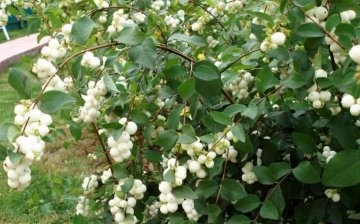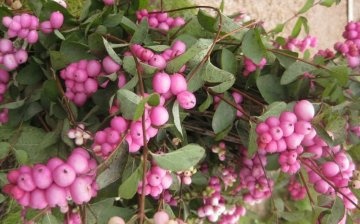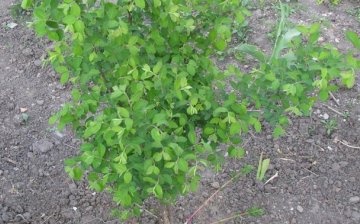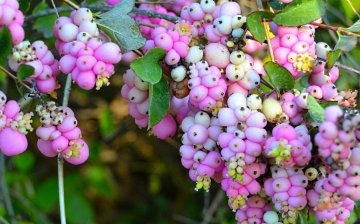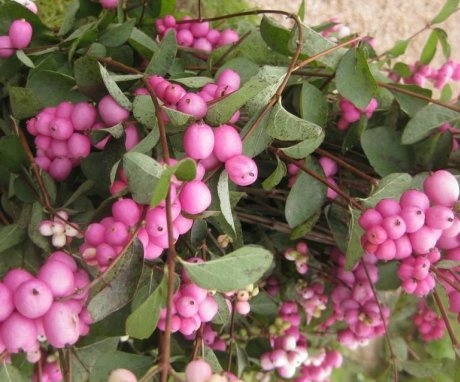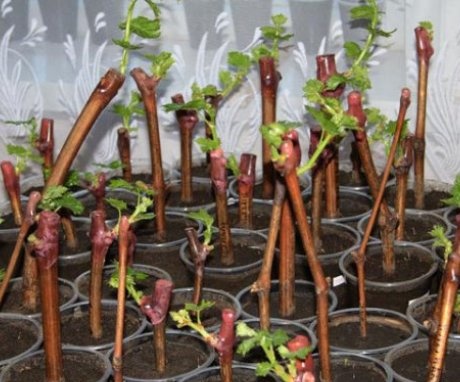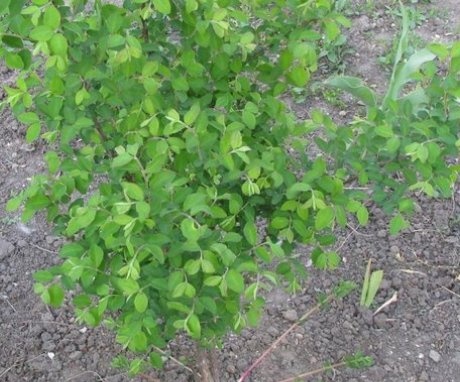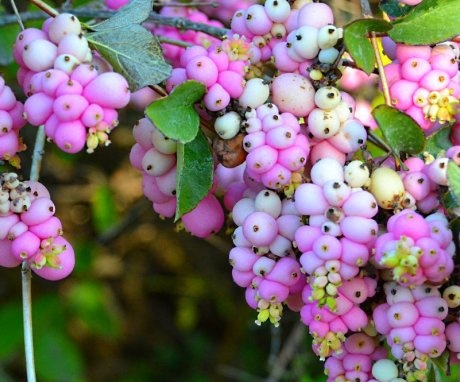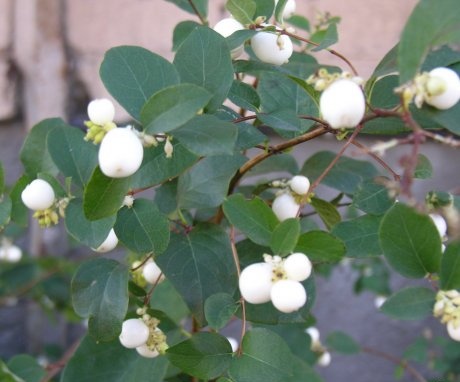Snowberry in the garden - all about growing a shrub
Snowberry is an ornamental shrub of the Honeysuckle family with original inedible fruits, the color of which depends on the variety and can be varied. There are 15 species of this plant, most of which grow wild in America, and only one in China.
The advantage of the snowberry is that it can grow in the shade. This makes it possible to use it for landscaping the site. The snowberry has been used in horticulture for about 200 years.
Content:
- Description and types of snowberry
- Reproduction methods
- Planting a snowberry
- Care Tips
- Snowberry pruning
- Shrub diseases
Description and types of snowberry
Snowberry is a shrub 0.3-2 m high. The Latin name is Symphoricarpos, which means "fruits gathered together." The leaves are round, ovate, opposite, up to 6 cm long. The leaves of some varieties have small teeth.
The petioles are short; one or 2 lobes are located near the base of the leaf. The upper part of the leaf is dark green, the bottom is gray. In autumn, the leaves acquire a yellow-red color, which makes the bush even more beautiful.
The branches are thin and flexible, do not break in winter under the snow, which clings to the bunches of fruits. Bell flowers are white with a green tint, pink or red. They are collected in inflorescences, each of which contains from 5 to 15 pieces. Inflorescences racemose or axillary. Flowering begins late, in July or early August, and lasts a long time, about 2 months. Snowberry is a good honey plant.
After flowering, in place of flowers, fruits are formed - juicy drupes in the form of a ball or ellipse.
The diameter of the fruit is 1-2 cm, the color is white, red or dark purple. Inside there are 1-3 small flat bones. The pulp looks shiny, beautiful, like snow. But you cannot eat it, it is slightly poisonous. The fruits are tightly adjacent to each other. The scientific name Symphoricarpos is associated with this.
Snowberry fruits can remain on branches until spring or until they become food for birds. Bushes can grow up to 50 years old. They grow quickly, the root system is actively developing.
Types of snowberry:
| Name | Description | Shrub features |
| White (tassel) | The flowers are pink-green, the fruits are white, the leaves are up to 6 cm long. The shoots are inclined to the ground. | Heat-loving plant, undemanding to growing conditions, grows in the shade. |
| Chinese | Fruits are black (dark purple) in color. | In the wild, it grows only in the western provinces of China. |
| Pink | Differs in pink or purple fruits up to 0.6 cm in diameter. | Afraid of frost. |
| Shenolta | Hybrid pink with pointed leaves, pink flowers and fruits. In the shade, the fruits are white with pink barrels. | Withstands frost under cover. |
| Dorenboza | A bush with pink pearl flowers and white fruits with a pink crown. | Low frost resistance. Responds well to thinning |
| Rounded | A bush with cream flowers, pink fruits. | Hardy, the bush is covered with fruits. |
| West | Leaves up to 10 cm long. Flowers are small, pale pink. The fruits are white at first, then they turn blue. | Unpretentious to growing conditions. |
| Soft | The flowers are bright pink, purple, the fruits are white with a pink barrel. | Creeping shrub. |
| Small-leaved | The flowers are light pink, the fruits are white with a pink tint. | Bush up to 3 m high. |
| City-loving | The flowers are white or with a pink tint. The fruits are snow-white. | Bush up to 2 m high. |
Snowberry bushes are used for landscaping small areas or creating hedges.
Reproduction methods
Snowberry breeds in several ways:
- Seeds. Seed propagation requires a lot of time and attention. Seeds are chosen from fruits, not forgetting that their pulp is poisonous. Insist in water to remove the pulp. So that small seeds are not lost, they are placed in a nylon stocking before processing. Dried, stored until late autumn. Closer to winter, they are sown in boxes. A loose soil is prepared, consisting of river sand, humus and peat. Taken in equal amounts. Seeds are sown, sprinkled with sand on top, watered and covered with glass. Pour from a spray bottle or into a pan. The seeds will appear in the spring, at the beginning of autumn the seedlings are transplanted into open ground.
- By dividing the bush. It is easy to propagate a snowberry with root shoots. A lot of growth grows from the roots of the bush. She thickens the planting. Therefore, young shoots with parts of the roots are transplanted to a new place. The division of the bush is carried out in early spring, until the leaves have blossomed. Dig out a bush, divide it into parts. The cut site is treated with crushed charcoal. Young bushes are planted in a permanent place.
- Layers. Reproduction by layering begins in the spring. Bend young shoots to the ground, dig holes up to 10 cm deep. Attach them with a wooden hook. Sprinkle with earth, leaving the top on the surface. Water it periodically to keep the soil moist. In the fall, the layering is separated from the mother bush and planted separately.
- Cuttings. The snowberry is propagated by green and lignified cuttings. The length of the cuttings is up to 20 cm. Each of them must have at least 3 buds. Lignified cuttings are prepared in late autumn or early winter. Store in a basement in wet sand. The upper cut is made over the kidney, the lower cut obliquely. Green cuttings are cut early in the morning or in cloudy weather. When bent, the shoots should break with a crunch. This indicates their suitability for root formation. Place the cuttings in the water. Prepare the soil in the same way as for seed propagation. Cuttings are installed to a depth of 5 cm. They are placed in a mini-greenhouse with high air humidity. The land is watered sparingly. In the fall, rooted cuttings are planted in open ground, mulch... Cover with spruce branches and dry leaves. The first years the bushes are covered with earth.
Planting a snowberry
Young snowberry bushes are planted to a depth of 60 cm. The holes are prepared in advance for planting in spring and autumn. This is especially important for clay soil. By the time of planting, it should settle so as not to damage the root system.
The soil taken out of the pit is mixed with humus, peat, sand. A layer of rubble is laid at the bottom for drainage. A handful of dolomite flour (to deoxidize the soil), superphosphate, wood ash (for plant feeding). Prepare 2-4 year old seedlings. The older they are, the faster they will form decorative plantings or hedges.
Before planting, the roots of the plants are dipped in a clay mash with the consistency of sour cream.
The seedlings are immersed along the root collar. Sprinkle with prepared soil, filling all the holes. Watering, mulching the area under the bush. The first week is watered every day.
When planting several seedlings, the distance between them is at least 120 cm. If the number of seedlings is large, a trench for them can be dug with a bulldozer. 1 seedling is planted per 1 running meter.
Care Tips
Snowberry is a very unpretentious plant:
- The bushes tolerate the lack of moisture well, but to increase their decorative properties, the bushes are watered abundantly. Bring in up to 2 buckets of water per 1 m2. For watering, it is better to use a drip irrigation system.If it rains frequently, the bushes are not watered.
- The soil around the bushes is loosened to a depth of 8 cm. Weeds are removed. A layer of mulch is poured so that its thickness is not less than 5 cm.
- They are fed with nitrogen fertilizers for active growth of shoots and leaves, phosphorus and potassium fertilizers for abundant flowering and fruiting. In the spring, add 5 kg of humus or compost, 100 g of potassium salt and superphosphate.
- In the fall, they dig up the ground around the bushes. The layer of mulch is increased near the young pieces. Varieties that do not tolerate frost are covered with spruce branches, non-woven materials.
If the bush needs to be transplanted to another place, it is better to do it early. The feeding area of an adult bush is a circle with a radius of up to 1 m. Therefore, it is difficult to remove it from the ground without harm to the roots. You need to dig a circle with a radius of at least 70 cm.
Useful video about the correct planting of a snowberry:
Snowberry pruning
In order for the bushes of the snowberry to have a neat appearance, they are periodically pruned. The first time this is done in early spring, before bud break. Cut from a quarter to half the length. In the summer, sanitary pruning is carried out as needed, cutting off broken and damaged branches.
Once every few years, they carry out sanitary pruning of the bush.
All thickened branches that cross and grow inside the bush are cut off. The plant grows back quickly after such pruning.
An old bush that has lost its decorative appearance can be rejuvenated. To do this, cut off all the branches at a height of about half a meter above the ground. The place of the cut is covered with garden pitch. Over the course of a year, new shoots will grow, and the next season the bush will again have a decorative appearance.
Shrub diseases
The snowberry is resistant to most diseases, pests bypass it. Sometimes the bushes are damaged by powdery mildew. This is a fungal disease that actively develops under the influence of high humidity at high temperatures.
Fruits can be affected by gray mold. To get rid of the disease, in early spring, the bushes are sprayed with a 3% solution of Bordeaux liquid or one of the fungicides:
- Quadris
- Speed
- Topaz
- Fundazol
More information about growing a snowberry can be found in the video:




